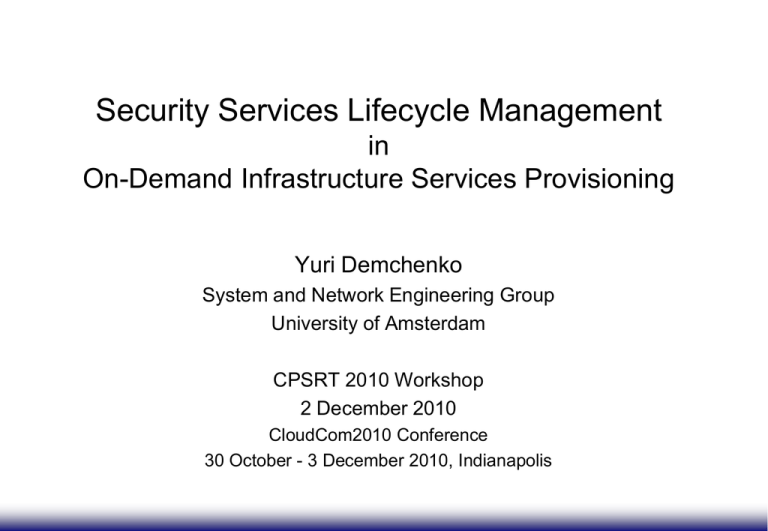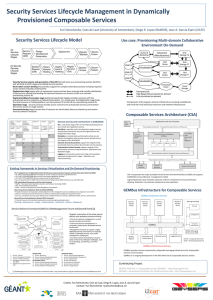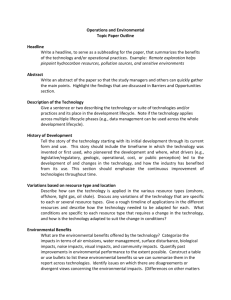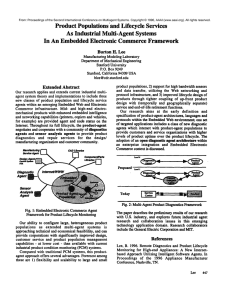Security Services Lifecycle Management in On-Demand Infrastructure Services Provisioning Yuri Demchenko
advertisement

Security Services Lifecycle Management in On-Demand Infrastructure Services Provisioning Yuri Demchenko System and Network Engineering Group University of Amsterdam CPSRT 2010 Workshop 2 December 2010 CloudCom2010 Conference 30 October - 3 December 2010, Indianapolis Outline • Background for this research • On-Demand Infrastructure Services Provisioning and Composable Services Architecture (CSA) CSA Service Delivery Framework and Services Lifecycle Management • Proposed Security Services Lifecycle Management and related security mechanisms • Implementation – GAAA Toolkit and Security sessions management • Summary and Discussion CPSRT2010 Workshop, 2 December 2010 Security Services Lifecycle Management Slide_2 Background to this research • Current projects GEANT3 JRA3 Composable Services – European NREN infrastructure GEYSERS – On-demand Optical + IT infrastructure resources provisioning – Wide participation from large European network (Telefonika, Alcatel-Lucent, Interoute) and application providers (SAP) • Past projects EGEE Grid Security middleware – gLite Java Authorisation Framework Phosphorus project Security architecture for multi-domain Network Resource Provisioning – GAAA-NRP and XACML-NRP profile – Multidomain Network Resource Provisioning (NRP) model and workflow CPSRT2010 Workshop, 2 December 2010 Security Services Lifecycle Management Slide_3 Use Case – e-Science infrastructure Control & Monitoring User A Grid Center Grid Storage T1 Initial effort to build – estimated 2 Yrs Outsource to current telco provider – approx. 2 months Grid Center Grid Storage T1 Target with new business model – 2 hrs Instrument (Manufactoring) Grid Storage T0 Visualisation User K User P Visualisation Computing Cloud Cloud Storage Permanent link High Speed link provisioned on demand Link provisioned on-demand Components of the typical e-Science infrastructure involving multidomain and multi-tier Grid and Cloud resources and network infrastructure CPSRT2010 Workshop, 2 December 2010 Security Services Lifecycle Management Slide_4 Use Case – e-Science infrastructure Control & Monitoring User A Instrument (Manufactoring) Grid Storage T0 Grid Center Grid Storage T1 Grid Center Grid Storage T1 Visualisation User K User P Visualisation Computing Cloud Cloud Storage Permanent link High Speed link provisioned on demand Link provisioned on-demand On-demand infrastructure services provisioning environment • Security along the whole provisioning process and service/infrastructure lifecycle • Manageable/user controlled security • Securing remote executing environment • Security context/session management Components of the typical e-Science infrastructure involving multidomain and multi-tier Grid and Cloud resources and network infrastructure CPSRT2010 Workshop, 2 December 2010 Security Services Lifecycle Management Slide_5 GEYSERS Reference Model for Infrastructure Virtualisation Roles: • • • CPSRT2010 Workshop, 2 December 2010 Security Services Lifecycle Management VIO – Virtual Infrastructure Operator VIP - Virtual Infrastructure Provider PIP - Physical Infrastructure Provider Slide_6 Security Service Lifecycle Management in On-Demand Resources/Services Provisioning • On-Demand Infrastructure Services Provisioning requires definition of Services Lifecycle Management Multidomain multi-provider environment Includes standard virtualisation procedures and mechanisms • Requires dynamic creation of Security/Trust Federations in multi-domain environment Based on available Trust Anchors – Physical Resources (hosting platforms) – SLA or SLA negotiators/contractors – All other security context/credentials/keys should be derived from them • Access control infrastructure dynamically created and policy/attributes dynamically configured Access/authorisation session/context management • Composable Services Architecture (CSA) as a platform for dynamically configurable composable services provisioning CPSRT2010 Workshop, 2 December 2010 Security Services Lifecycle Management Slide_7 Composable Services Architecture User Client Applications and User Terminals Virtual Infrastructure/Resources level Proxy (adaptors/containers) – Composed/Virtualised Services and Resources Control & Management Plane Composition Layer/Serv Composable Services Middleware (GEMBus) (Reservation SLA Negotiatn) (Operation, Orchestration) MD SLC Registry Logging Composable Services lifecycle/provisioning stages (1) Request (2) Composition/ Reservation (3) Deployment (4) Operation (5) Decommissioning Security Separation of Data Plane, Control Plane, Management Plane Logical Abstraction Layer for Component Services and Resources Proxy (adaptors/containers) - Component Services and Resources Storage Resources Compute Resources Network Infrastructure Component Services & Resources – Physical Resources level CPSRT2010 Workshop, 2 December 2010 Security Services Lifecycle Management Control/ Mngnt Links Data Links Slide_8 CSA Services Delivery Framework (SDF) Composable Services Provisioning Workflow Main stages/phases Service Request/ SLA Negotiation • • Composition/ Reservation Re-Compo sition • Service Lifecycle Metadata Service (SL MD) Deployment • • Additional stages • Registr&Synchro Recovery/ Migration Operation (Monitoring) Decommissioning Service Request (including SLA negotiation) Composition/Reservation (aka design) Deployment, including Reqistration/Synchronisation Operation (including Monitoring) Decommissioning • Provisiong Session Managnt Re-Composition should address incremental infrastructure changes Recovery/Migration can use SL-MD to initiate resources resynchronisation but may require recomposition The whole workflow is supported by the Service Lifecycle Metadata Service (SL MD) Based on the TMF SDF CPSRT2010 Workshop, 2 December 2010 Security Services Lifecycle Management Slide_9 TMF Service Delivery Framework (SDF) Goal: Automation of the whole service delivery and operation process (TMF SDF, http://www.tmforum.org/ServiceDeliveryFramework/4664/home.html) End-to-end service management in a multi-service providers environment End-to-end service management in a composite, hosted and/or syndicated service environment Management functions to support a highly distributed service environment, for example unified or federated security, user profile management, charging etc. Any other scenario that pertains to a given phase of the service lifecycle challenges, such as on-boarding, provisioning, or service creation CPSRT2010 Workshop, 2 December 2010 Security Services Lifecycle Management Slide_10 SDF Reference Architecture (refactored from SDF) Design 16 SDF Service Design Management (ISS) Deploy SDF Service Repository (ISS) 9 10 SDF Service Lifecycle Metadata Repository (ISS) 17 11 SDF Service Lifecycle Metadata Coordination (ISS) SDF Service Deployment Management (ISS) 2 Operate SDF Service State Monitor (ISS) 6 SDF Service Provisng Mngnt (MSS) SDF Service Instance 6 SDF Service Quality/ Problem Mngnt (MSS) 1 3 SDF Service Resource Fulfillment (ISS) SDF Service Resource Monitor (ISS) 7 SDF Service Usage Mngnt (MSS) SDF MSS Composite Services provisioned on-demand 4 CPSRT2010 Workshop, 2 December 2010 12 13 14 15 SDF Service Resource Usage Monitor (ISS) SDF ISS Security Services Lifecycle Management 8 1 – Service Instance 2 - Service Management Interface 3 – Service Functional Interface 4 - Management Support Service (SDF MSS) 8 - Infrastructure Support Service (ISS) DESIGN stage 9 - Service Repository 10 - Service Lifecycle Metadata Repository 16 - Service Design Management DEPLOYMENT stage 10 - Service Lifecycle Metadata Repository 11 - Service Lifecycle Metadata Coordinator 17 - Service Deployment Management OPERATION stage 5 - Service Provisioning Management 6 - Service Quality/Problem Management 7 - Service Usage Monitor 12 - Service State Monitor 13 - Service Resource Fulfillment 14 - Service Resource Monitor 15 - Resource Usage Monitor Slide_11 Composable Services Architecture – Lifecycle stages workflow 4 4 Serv User Client Serv Applications and User Terminals Serv Proxy (adaptors/containers) – Composed/Virtualised Services and Resources 4 3 1 3 2 2 3 Control & Management Plane 1 (Operation, Orchestration) 4 (Reservation SLA Negotiatn) 2 MD SLC (1) Request (2) Composition/ Reservation (3) Deployment (4) Operation (5) Decommissioning Composition Layer /Serv Composable Services Middleware (GEMBus/GESB) Registry Logging Composable Services lifecycle/provisioning stages Security 3 2 MD SLC – Service Lifecycle Metadata Logical Abstraction Layer for Component Services and Resources 3 2 4 4 Proxy (adaptors/containers) - Component Services and Resources Storage Resources Compute Resources CPSRT2010 Workshop, 2 December 2010 3 2 Network Infrastructure Component Services & Resources Security Services Lifecycle Management GEMBus – GEANT Multidomain Bus Control/ Mngnt Links Data Links Slide_12 Security Services Lifecycle Management Model (compliant to CSA SDF/lifecycle model) Security Service request and generation of the GRI that will serve as a provisioning session identifier and will bind all other stages and related security context. Reservation session binding that provides support for complex reservation process including required access control and policy enforcement. Deployment stage begins after all component resources have been reserved and includes distribution of the security context and binding the reserved resources or services to GRI as a common provisioning session ID. Registration&Synchronisation stage (optional) specifically targets possible scenarios with the provisioned services migration or failover/interruption. In a simple case, the Registration stage binds the local resource or hosting platform run-time process ID to the GRI as a provisioning session ID. Operation stage - security services provide access control to the provisioned services and maintain the service access or usage session. Decommissioning stage ensures that all sessions are terminated, data are cleaned up and session security context is recycled. Service Request (GRI) CPSRT2010 Workshop, 2 December 2010 Reserv Session Binding Deployment & RsrBind Registr Synchro (Opt) Security Services Lifecycle Management Operatn Access Decommision Slide_13 Relation between SecuritySLM and general SLM (a) Services Lifecycle Stages (b) Security Services Lifecycle Stages Service Request (GRI) Design Development Reservation SecServ Request (GRI) Reserv Session Binding Deployment Deployment & RsrBind Registr Synchro (Ext) Operate Maintain Decommision Operatn Access Decommision Additional SSLM stages and mechanisms to ensure consistency of the security context management Security Service Request that initiates creation of the dynamic security association and may use SLA security context. Reservation Session Binding with GRI (as part of Planning stage) that provides support for complex reservation process including required access control and policy enforcement. Registration&Synchronisation stage (as part Deployment stage) specifically targets possible scenarios with the provisioned services migration or failover/interruption. In a simple case, the Registration stage binds the local resource or hosting platform run-time process ID to the GRI as a provisioning session ID. CPSRT2010 Workshop, 2 December 2010 Security Services Lifecycle Management Slide_14 Relation between SSLM/SLM stages and supporting general and security mechanisms SLM stages Request Process/ Activity SLA tiation Nego Design/Reservation Development Deployment Operation Decomissioni ng Service/ Resource Composition Reservation Composition Configuration Orchestration/ Session Management Logoff Accounting Mechanisms/Methods SLA V Workflow Metadata V (V) V V V V V Dynamic Security Associatn (V) V V AuthZ Session Context V (V) V Logging (V) (V) V CPSRT2010 Workshop, 2 December 2010 Security Services Lifecycle Management V Slide_15 Implementation suggestions Extend existing GAAA-Toolkit pluggable Java library to support dynamic Security/AAI infrastructure creation and integration with provisioned VI • Provides GAAA Authorisation API (GAAAPI) functions with extended AuthZ and session management functionality Support for SDF workflow and Security Services Lifecycle Management • Needs general infrastructure services such as Metadata SLM Define and implement Common Security Service Interface (CSSI) • Supports both internal applications calls and Web service integration via Spring security • Implements GSS-API and extends it with GAAAPI functionality Use standard Messaging, Transport and Network security mechanisms provided by implementation platform • Implementation platform selection – ESB/WS/SOA (Fuse, Apache ServiceMix, etc.) CPSRT2010 Workshop, 2 December 2010 Security Services Lifecycle Management Slide_16 Multidomain Network/Complex Resource Provisioning (NRP/CRP) – Provisioning sequences Agent (AAA) A R Provisioning sequences NSP/AAA NSP/AAA PAP PAP PDP PDP P User Client TVS NSP/AAA PAP PDP TVS TVS PEP PEP DC/NRPS DC/NRPS DC/NRPS NE NRPS – Network Resource Provisioning System NSP – Network Service Plain DC – Domain Controller IDC – Interdomain Controller GridNets2009, 8-9 September 2009, Athens Service (AAA) plane Dest Host Applicatio n NE Agent (A) Polling (P) Relay (R) Token based policy enforcement Control plane PEP NE DC/A AA GRI – Global Reservation ID AuthZ tickets for multidomain context mngnt T - Token Network plane AAA – AuthN, AuthZ, Accounting Server PDP – Policy Decision Point PEP – Policy Enforcement Point TVS – Token Validation Service KGS – Key Generation Service Multidomain Complex Resource Provisioning (СRP) – Stage 1 – Path building and Advance Reservation Token based signalling and access control IDC/AAA PAP GRI PAP GRI PDP PDP TVS User Client IDC/AAA IDC/AAA PAP GRI PDP TVS TVS PEP PEP DC/NRPS DC/NRPS DC/NRPS NE IDC – Interdomain Controller DC – Domain Controller NRPS – Network Resource Provisioning System NE - Network Element GridNets2009, 8-9 September 2009, Athens NE Service (AAA) plane Dest Host Control plane PEP NE DC/A AA GRI – Global Reservation ID AzTicket – AuthZ ticket for multidomain context mngnt AT – Access Token Pilot Token type 3 used at the Stage 1 Reservation for signalling and interdomain context communication * As container for GRI and AzTicket Applicatio n Network plane Pilot Token type 4 used at the Stage 2 for setup information communication AAA – AuthN, AuthZ, Accounting Server PDP – Policy Decision Point PEP – Policy Enforcement Point TVS – Token Validation Service Multidomain Complex Resource Provisioning (СRP) – Stage 2 – Deployment (setup and key distribution) Token based signalling and access control IDC/AAA PAP GRI PAP GRI PDP PDP TVS User Client IDC/AAA IDC/AAA PT4(AzTick) PAP GRI PDP TVS PT4(AzTick) TVS PEP PEP DC/NRPS DC/NRPS DC/NRPS NE IDC – Interdomain Controller DC – Domain Controller NRPS – Network Resource Provisioning System NE - Network Element GridNets2009, 8-9 September 2009, Athens NE Service (AAA) plane Dest Host Control plane PEP NE DC/A AA GRI – Global Reservation ID AzTicket – AuthZ ticket for multidomain context mngnt AT – Access Token Pilot Token type 3 used at the Stage 1 Reservation for signalling and interdomain context communication * As container for GRI and AzTicket Applicatio n Network plane Pilot Token type 4 used at the Stage 2 for setup information communication AAA – AuthN, AuthZ, Accounting Server PDP – Policy Decision Point PEP – Policy Enforcement Point TVS – Token Validation Service Multidomain Complex Resource Provisioning (СRP) – Stage 3 – Access Control (using access tokens) Token based signalling and access control IDC/AAA PAP IDC/AAA IDC/AAA GRI PAP GRI PDP PDP PDP PT4(AzTick) PT4(AzTick) AT User Client TVS AT PAP GRI TVS AT TVS AT PEP PEP PEP DC/NRPS DC/NRPS DC/NRPS NE NE IDC – Interdomain Controller DC – Domain Controller NRPS – Network Resource Provisioning System NE - Network Element GridNets2009, 8-9 September 2009, Athens DC/A AA NE Service (AAA) plane Dest Host Control plane GRI – Global Reservation ID AzTicket – AuthZ ticket for multidomain context mngnt AT – Access Token Pilot Token type 3 used at the Stage 1 Reservation for signalling and interdomain context communication * As container for GRI and AzTicket Applicatio n Network plane Pilot Token type 4 used at the Stage 2 for setup information communication AAA – AuthN, AuthZ, Accounting Server PDP – Policy Decision Point PEP – Policy Enforcement Point TVS – Token Validation Service СRP Stages and Authorisation Session Types SLA, WSAgreement Access Control Policy GRI generated Accounting, Billing Network Config. Reservation Deployment Access/Use Decommissioning AccessToken PilotToken0-3 PilotToken4 Reservation Session Access Session Provisioning session Requires consistent security and session context management Global Reservation ID (GRI) is created at the beginning of the provisioning session (Reservation stage) and binds all sessions GridNets2009, 8-9 September 2009, Athens Access Token and Pilot Token Types AType 0 – Simple access token (refers to the reserved resources context) AType 1 – Access token containing Obligations collected from previous domains PType 0 – Container for GRI only PType 1 – Container for communicating the GRI during the reservation stage • Contains the mandatory SessionId=GRI attribute and an optional Condition element PType 2 – Origin/requestor authenticating token • TokenValue element contains a value that can be used as the authentication value for the token origin • TokenValue may be calculated of the (GRI, IssuerId, TokenId) by applying e.g. HMAC function with the requestor’s symmetric or private key. PType 3 – Extends Type 2 with the Domains element that allows collecting domains security context information when passing multiple domains during the reservation process • Domains’ context may include the previous token and the domain’s trust anchor or public key PType 4 – Used at the deployment stage and can communicate between domains security context information about all participating in the provisioned lightpath or network infrastructure resources • Can be used for programming/setting up a TVS infrastructure for consistent access control tokens processing at the resource access stage GridNets2009, 8-9 September 2009, Athens XML Token Format – Access and Pilot Tokens Support inter-domain security/session context communication to allows multidomain provisioning scenarios Ensure Integrity of the AuthZ decision Keeps AuthN/AuthZ context Allow Obligated Decisions (e.g. XACML Obligations) Supports simple delegation scenarios Can be used for establish session-based trust relations between domains Allows easy mapping to SAML and XACML related elements GridNets2009, 8-9 September 2009, Athens Chaining Pilot Tokens in multidomain signalling Requestor Domain1 “viola” Domain2 “uva” Domain3 “uclp” Resource * Pilot Token type 3 issued by domain UVA <AAA:AuthzToken xmlns:AAA="http://www.aaauthreach.org/ns/AAA" Issuer=http://testbed.ist-phosphorus.eu/uva/AAA/TVS/tokenpilot SessionId="740b241e711ece3b128c97f990c282adcbf476bb" TokenId="dc58b505f9690692f7a6312912d0fb4c" type="pilot-type3"> <AAA:TokenValue>190a3c1554a500e912ea75a367c822c09eceaa2f </AAA:TokenValue> <AAA:Conditions NotBefore="2009-01-30T08:57:40.462Z" NotOnOrAfter="2009-01-30T09:21:40.462Z"/> <AAA:DomainsContext> <AAA:Domain domainId="http://testbed.ist-phosphorus.eu/viola"> <AAA:AuthzToken Issuer="http://testbed.ist-phosphorus.eu/viola/aaa/TVS/token-pilot« SessionId="2515ab7803a86397f3d60c670d199010aa96cb51" TokenId="c44a2f5f70346fdc2a2244fecbcdd244"> <AAA:TokenValue>dee1c29719b9098b361cab4cfcd086700ca2f414 </AAA:TokenValue> <AAA:Conditions NotBefore="2009-01-30T07:57:35.227Z" NotOnOrAfter="2009-01-31T07:57:35.227Z"/> </AAA:AuthzToken> <AAA:KeyInfo> http://testbed.ist-phosphorus.eu/viola/_public_key_ </AAA:KeyInfo> </AAA:Domain> </AAA:DomainsContext> </AAA:AuthzToken> GridNets2009, 8-9 September 2009, Athens Future work and Discussion • Definition of and reference implementation of the Common Security Services Interface (CSSI) As extension to industry adopted GSS-API Incorporate GAAA-AuthZ (RFC2904) Authorisation interface Extends for Session Security Context Management and dynamic trust/security association management • Wide range of formalisation and modeling work • Implementation in projects GEANT3 and GEYSERS • CSA and Security Services Lifecycle Management model is proposed as a possible deliverable for OGF ISOD RG CPSRT2010 Workshop, 2 December 2010 Security Services Lifecycle Management Slide_25 Additional Information • TMF SDF Lifecycle Management model CPSRT2010 Workshop, 2 December 2010 Security Services Lifecycle Management Slide_26 AuthN/AuthZ Infrastructure (AAI) in GEYSERS CSSI Basic CSSI services SML NIPS-UNI NIPS Server SLI NCP CCI LICL NLI GEYSERS Security (AAI) VITM LPI Data encryption Digital signature Authentication Authorization Policy management Security session and context management Called from services (or part of core interfaces) SLI (SML-LICL) CCI (NCP-LICL) NLI (NCP-LICL) LPI (LICL-PHY) NIPS-UNI PHY CPSRT2010 Workshop, 2 December 2010 Security Services Lifecycle Management Slide_27 GEYSERS AAI Reference Model AAI Gateway Common Security Services Interface (CSSI) PEP AuthN Service SecCtx Handler Token Validation Service (TVS) PDP AuthN DB PAP Dyn AC Service Mngnt Config, Attr Trust/Key Mngnt PEP: Policy Enforcement Point PDP: Policy Decision Point PAP: Policy Administration Point DACS: Dynamic Access Control Service CPSRT2010 Workshop, 2 December 2010 Security Services Lifecycle Management Slide_28 GEMBus Infrastructure for Composable Service GEMBus Component Services Service 1 Service 2 Service 3 Service 4 (CSrvID, SesID) (CSrvID, SesID) (CSrvID, SesID) (CSrvID, SesID) Message Handling Routing Configur ation Interceptors (AspOrient) ESB GEMBus Messaging Infrastructure (GMI) GEMBus Registry Composition & Orchestration Security Service Logging Service GEMBus Infrastructure Services CPSRT2010 Workshop, 2 December 2010 Security Services Lifecycle Management GMI provides common dynamically configurable messaging infrastructure for Composable services communication Slide_29 Example Service Composition – Service NX Service 4 Composed Service NX (CSrvID,SesID) (CSrvID,SesID) UserClient Service 3 Service 1 Service 2 (CSrvID,SesID) (CSrvID,SesID) (CSrvID,SesID) (CSrvID,SesID) Service 4 Composed Service NX (CSrvID,SesID) (CSrvID,SesID) User Interface UserClient Frontend CompSrvNX (CSrvID,SesID) (CSrvID,SesID) CPSRT2010 Workshop, 2 December 2010 Service 3 Service 1 Service 2 (CSrvID,SesID) (CSrvID,SesID) (CSrvID,SesID) Security Services Lifecycle Management Role and place for Composition and Orchestration * Composable services or GEMBus infrastructure service CSrvID, SesID – bind component services into the on-demand provisioned Composed service NX Slide_30 GEYSERS Reference Model Role: • VIO • VIP • PIP CPSRT2010 Workshop, 2 December 2010 Security Services Lifecycle Management Slide_31 Role of GEYSERS actors with respect to its architectural layers CPSRT2010 Workshop, 2 December 2010 Security Services Lifecycle Management Slide_32 GEYSERS Service Delivery Framework (SDF) • Service provisioning workflow by VIP: Creation of the Virtual Infrastructure (VI) May include more engineers support • Service provisioning workflow by VIO: Creation and operation of the Virtual Infrastructure on-demand for specific project, tasks or user groups Should be completely automatic • Should also include activities/stages for infrastructure re-planning, restoration and migration • Adopted TeleManagement Forum Service Delivery Framework (TMF SDF) • GEYSERS Project - http://www.geysers.eu/ CPSRT2010 Workshop, 2 December 2010 Security Services Lifecycle Management Slide_33 GEYSSERS Service Delivery Framework/Workflow Service Request/ SLA Negotiation Replanning Services Provisioning Workflow by VIP Service Request/ SLA Negotiation Planning (Compos/Reserv) Planning (Design) Geysers SDF supports both Geysers infrastructure development and deployments and its operation for on-demand Infrastructure services provisioning by VIO RePlanning Deployment Deployment (Instant& Config&Synchro) Recovery/ Migration Operation &Monitoring (by VIO) Network+IT Services Provisioning Workflow by VIO Registr&Synchro Recovery/ Migration Operation (Monitoring) Decommissioning Decommissioning CPSRT2010 Workshop, 2 December 2010 Security Services Lifecycle Management Slide_34 Existing framework in on-Demand Infrastructure Services Provisioning and Lifecylce Management TMF standardised frameworks, practices and procedures • SDF - Service Delivery Framework • SLA management • NGOSS – New Generation Operations System Services (including eTOM) Microsoft Security Development Lifecycle (SDL) Framework • Primarily focused on the product development process by engineers/programmers (Training) – Requirements – Design – Implementation – Verification – Release – (Response) CPSRT2010 Workshop, 2 December 2010 Security Services Lifecycle Management Slide_35 SDF main stages and phases Main stages/phases • • • • • Service Request (including SLA negotiation) Planning (including Composition, Reservation and Design) Deployment (including Reqistration/Synchronisation) Operation (including Monitoring) Decommissioning Additional stages • Re-Composition should address incremental infrastructure changes • Recovery/Migration can use SL-MD to initiate resources re-synchronisation but may require recomposition The whole workflow should be supported by the Service Lifecycle Metadata Service (SL MD) CPSRT2010 Workshop, 2 December 2010 Security Services Lifecycle Management Slide_36







